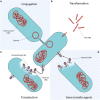Dissemination of Antimicrobial Resistance in Microbial Ecosystems through Horizontal Gene Transfer
- PMID: 26925045
- PMCID: PMC4759269
- DOI: 10.3389/fmicb.2016.00173
Dissemination of Antimicrobial Resistance in Microbial Ecosystems through Horizontal Gene Transfer
Abstract
The emergence and spread of antibiotic resistance among pathogenic bacteria has been a rising problem for public health in recent decades. It is becoming increasingly recognized that not only antibiotic resistance genes (ARGs) encountered in clinical pathogens are of relevance, but rather, all pathogenic, commensal as well as environmental bacteria-and also mobile genetic elements and bacteriophages-form a reservoir of ARGs (the resistome) from which pathogenic bacteria can acquire resistance via horizontal gene transfer (HGT). HGT has caused antibiotic resistance to spread from commensal and environmental species to pathogenic ones, as has been shown for some clinically important ARGs. Of the three canonical mechanisms of HGT, conjugation is thought to have the greatest influence on the dissemination of ARGs. While transformation and transduction are deemed less important, recent discoveries suggest their role may be larger than previously thought. Understanding the extent of the resistome and how its mobilization to pathogenic bacteria takes place is essential for efforts to control the dissemination of these genes. Here, we will discuss the concept of the resistome, provide examples of HGT of clinically relevant ARGs and present an overview of the current knowledge of the contributions the various HGT mechanisms make to the spread of antibiotic resistance.
Keywords: GTA; antibiotic resistance; conjugation; gene transfer agents; lateral gene transfer; resistome; transduction; transformation.
Figures

References
Publication types
LinkOut - more resources
Full Text Sources
Other Literature Sources

